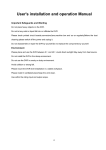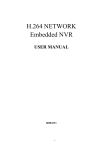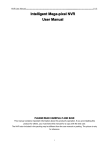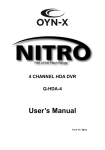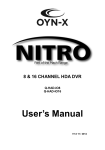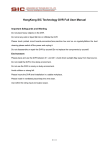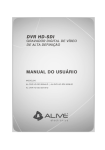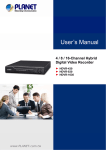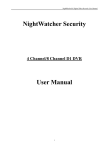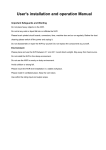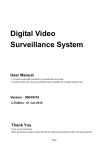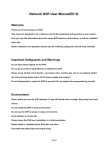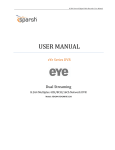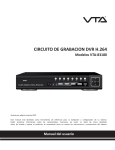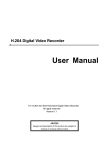Download User Manual - Conceptronic
Transcript
Professional 8-Channel CCTV Surveillance Kit User Manual C8CHCCTVKITP V1.1 CONTENTS 1. Products Introduce ............................................... 6 1.1 Technical Parameter ....................................................... 6 1.2 Product overview ................................................................ 6 1.3 Key Features ...................................................................... 7 2. Open-package check and cable connections ................ 8 2.1 Open-package check.......................................................... 8 2.2 HDD installation .................................................................. 8 2.4 Front/Rear panel The Front panel ................................ 10 2.5 Audio and video input and output connections ................ 11 2.5.1 Video input connections .............................................................. 11 2.5.2 Video output connections and options ......................................... 12 2.5.3 Audio signal input ........................................................................ 12 2.5.4 Audio signal output ...................................................................... 12 2.6 Speed dome connections ................................................. 12 3. Basic operation ................................................... 14 3.1 Turn on ............................................................................. 14 3.1 Turn off ............................................................................. 14 3.3 System Login .................................................................... 15 3.4 Preview ............................................................................. 15 3.5 Desktop shortcut menu..................................................... 15 1 3.5.1 Main menu .................................................................................. 16 3.5.2 Playback ..................................................................................... 16 3.5.3 Record Control ............................................................................ 19 3.5.4 PTZ control ............................................................................... 19 3.5.5 Color setting ................................................................................ 25 3.5.7 Output Adjust .............................................................................. 25 3.5.8 Logout ......................................................................................... 26 4. Main menu ......................................................... 28 4.2 Record .............................................................................. 30 4.2.2 Playback ..................................................................................... 31 4.2.3 Backup ........................................................................................ 31 4.3 Alarm Function ................................................................. 33 4.3.1 Motion Detect .............................................................................. 33 4.3.2 Video Blind .................................................................................. 36 4.3.3 Video Loss .................................................................................. 36 4.3.4 Abnormal..................................................................................... 37 4.4 System setup .................................................................... 38 4.4.1 General ....................................................................................... 38 4.4.2 Encode setup .............................................................................. 39 4.4.3 Network setup ............................................................................. 41 4.4.4 NetService .................................................................................. 42 2 4.4.5 GUI Display ................................................................................. 52 4.4.6 PTZ device /RS485 device .......................................................... 54 4.4.7 RS232 ......................................................................................... 55 4.4.8 Tour ............................................................................................ 55 4.4.9 Digital (Channel manage) ............................................................ 56 4.5 Advanced .......................................................................... 57 4.5.1 HDD Manage .............................................................................. 57 4.5.2 Account ....................................................................................... 58 4.5.3 Online user .................................................................................. 61 4.5.4 TV adjust ..................................................................................... 61 4.5.5 Auto Maintain .............................................................................. 62 4.5.6 Restore ....................................................................................... 62 4.5.7 Upgrade ...................................................................................... 63 4.5.9 Import / Export .......................................................................... 63 4.6 Info .................................................................................... 64 4.6.1 HDD info ..................................................................................... 64 4.6.2 BPS ............................................................................................. 65 4.6.3 LOG ............................................................................................ 65 4.6.4 Version ........................................................................................ 66 4.7 Shut down system ............................................................ 66 5. Mobile software instructions ................................... 67 3 5.1 Android version................................................................. 67 5.2 IOS version ....................................................................... 71 6. FAQ and maintenance ........................................... 76 6.1 FAQ .................................................................................. 76 6.2 Maintenance .................................................................. 82 4 Power This DVR adaptor is DC12V; please make sure the power supply voltage before turn on the machine. If long time do not use the machine, please turn off the power of DVR machine, and let the electric plug away from power socket; safety This DVR only for indoor use, as for prevent short circuit or electric danger, please do not let the DVR in the raining or humid area. In case any solid or liquid inside the case of DVR, please turn off the power immediately, and ask the qualified technician check it before reboot the DVR; The DVR is the precision machine, there is nothing for repair by customers themselves in it, when it break down, please ask the qualified technician to check and repair, or contact with the agents of it. Installation Please keep the DVR in level for installation; Pay attention to equipment ground; For the first time to install the DVR, please make sure if the hard disk drive install or not; Prevent to open the case and change the hard disk drive in electrified; Propose to select the performance of hard disk drive will be 7200 rotating speed person second; Please select the appropriate installation site, so let the air can be free flow inside the DVR, prevent the machine overheating; Please do not install the DVR nearby the radiator, air chute etc. heat source, or where the direct sunlight, too much dust, or mechanical vibration or attack; 5 1. Products Introduce 1.1Technical Parameter Video System Video Format Video Input Video Output (BNC) Video Output (VGA) Video Output (HDMI) Audio Input / Output Maximum Recording Rate Playback resolution Hard Disk Storage Recording Mode Multiplex Operation USB Mouse Control Motion Detection Area Backup Device Ethernet Mobile Surveillance Network Protocol IR Remote Control Picture Zoom PTZ Control Daylight Saving Power Source (±10%) Power Consumption (±10%) Operating Temperature Dimensions (mm) ** System Recovery NTSC / PAL H.264 8 channels (Composite video signal 1 Vp-p 75Ω BNC) Main Monitor Output (Composite video signal 1 Vp-p 75Ω BNC) Built-in (Output resolution up to 1920 x 1080) Built-in (Output resolution up to 1920 x 1080) 8 audio input, 1 audio output (RCA) 960×480 pixels with 120 FPS <NTSC> / 960×576 pixels with 96 FPS <PAL> 704×480 pixels with 240 I FPS <NTSC> / 704×576 pixels with 200 FPS <PAL> 704x240 pixels with 240 FPS <NTSC> / 704×288 pixels with 200 FPS <PAL> 352×240 pixels with 240 FPS <NTSC> / 352×288 pixels with 200 FPS <PAL> 8ch D1 or 2ch 960H Accommodates 2 SATA HDDs (1 HDD capacity up to 2TB) Manual / Timer / Motion / Alarm / Remote Live display / record / playback / backup / network operations YES 16 × 12 grids per channel USB 2.0 flash drive / USB mobile HDD / Network / USB DVD-RW 10/100 Base-T. Supports remote control and live view via Ethernet YES (Including IPad , Iphone, BlackBerry, Windows Mobile, Symbian & Android) TCP/IP, PPPOE, DHCP and DDNS Remotely control DVR and PTZ cameras via IR transmitter (IR receiver built-in) 1X digital zoom YES (built-in RS-485 port) YES DC 12V <7W without HDD -10℃ ~ 60℃ Dimension:245(L)x325(W)x52(H)mm System auto recovery after power failure 1.2 Product overview The Conceptronic Professional 8-Channel CCTV Surveillance Kit offers an ideal way to monitor a large house or building premises, for situations requiring professional-level surveillance. With superior quality, high-definition cameras stationed on all sides of the building, all access points can be securely watched at all times of the day and night. Sophisticated software allows easy monitoring of all eight cameras from any PC, laptop, tablet or smartphone. Cameras all conform to Weatherproof standard IP66, and operate in temperatures from -10°C to 50°C. Built-in infrared LEDs support night monitoring for distances up to 20 metres, providing crystal-clear images at any time, under any conditions. The quality cameras also offer full-screen, high resolution recording and playback. Storing your data is made easy and efficient with a high compression rate and two SATA HDD drives for recording up to 4TB of data (2TB per HDD ). Everything you need for safe, secure surveillance of your home or 6 business, providing the utmost in peace-of-mind. 1.3 Key Features 4 x 1/3" Sony Powerful EFFIO CCD & DSP 700TVL Day/Night Outdoor Cameras with an 8-CH Digital Video Recorder included. Two 2.5”/3.5" disk slots support storage capacity of up to 2TB each, providing space for up to 4 TB of storage. Built-in infrared LEDs for night viewing of up to 20m Weatherproof IP66-rated Wide operating temperature (-10°C to 50°C) D1 / 960H real time, full screen, high resolution recording H.264 compression for efficient data transfer and storage Built-in USB port for backup, firmware upgrade and mouse Supports VGA, HDMI output Supports iPhone/Android/Blackberry remote viewing over the Internet 7 2. Open-package check and cable connections 2.1 Open-package check When you receive the DVR, please check First, please check whether there is any visible damage to the package appearance. It protective materials used for the package of the DVR can protect most accidental clashes during transportation. Then, please open the box and get rid of the plastic protective materials. Check whether there is any visible damage to the DVR appearance. At last, please open the machine crust and check the data wire in the front panel, power wire, the connection between the fan power and the main board. 2.1.1 Front panel and rear panel The key function specification in the front panel and the interface specification in the real panel are in the specification. Please check the product type in the front panel whether is accordant with the product type you order. The label in the real panel is very important for the after service. Please protect it carefully. When you contact us for after service, please provide the product type and serial number in the label. 2.1.2 Check After open the cover, you should check if it has obvious damage trace, also please check the front panel data cable, power cord and motherboard's connection are loose or not. 2.2 HDD installation For the first use, please install the hard disk, this machine box can install two hard disk(no limited capacity). Remove the screws from the upper cover of the DVR and remove the cover. 8 Align the HDD in the case and fasten the screws from the bottom of the DVR. Install data and power cable for the hard disk. Close the top cover and fasten screws. Note : SATA hard disk inside the DVR does not support hot plugging. Please properly connect wires in the hard disk prior to booting. 9 2.3 Shelf installation This product chassis specification for the standard 1u,so it can be installed in the standard shelf. Installation steps and attention items: 1、Make sure the temperature in the room lower then 35℃ (95°f). 2、Keep the equipment have 15cm(6 inches)space around in order to air's circulation. 3、From bottom to shelf installation. 4、When multiple components install in the frame,please take preventive measures to avoid power socket overload. 2.4 Front/Rear panel The Front panel (1) Search (2) PTZ (3) INFO (4) REC (5) Shift (6) Power (7)Direction (8) Menu (9) ESC (10)Play/Pause (11)Back/Pause (13) Play (14)Next (15)Back The rear panel 10 (12)Fast 1 Audio Input 2 Video Input 3 Video Output 4 Audio output 5 VGA 6 HDMI 7 LAN 8 USB 9 10 RS-485 11 DC12V Power switch 2.5 Audio and video input and output connections 2.5.1 Video input connections The video input port is BNC connector plug. The demand of input signal is PAL/NTSC BNC(1.0VP-P,75Ω). The video signal must be accorded with the state standard which has the high signal to noise ratio, low aberration and low interference. The image must be clear and has natural color in the appropriate brightness. Insure the camera signal stable and credible The camera should be installed in the appropriate location where is away from backlighting and low illumination or adopts the better backlighting and low illumination compensation. The ground and power supply of the camera and the DVR should be shared and stable. Insure the transmission line stable and credible The video transmission line should adopt high quality coaxial pair which is chosen by the transmission distance. If the transmission distance is too far, it should adopt shielded twisted pair, video compensation equipment and transmit by fiber to insure the signal quality. The video signal line should be away from the electro magnetic Interference and other equipments signal lines. The high voltage current should be avoided especially. Insure the connection stable and credible 11 The signal and shield lines should be firm and connected credible which avoid false and joint welding and oxidation. 2.5.2 Video output connections and options The video output is divided into PAL/NTSC BNC(1.0VP-P,75Ω) and VGA output(selective configuration). When replace the monitor by the computer display, there are some issues to notice 1、Do not stay in the turn-on state for a long time. 2、Keep the computer display normal working by demagnetizing regularly. 3、Stay away from the electro magnetic Interference. TV is not a credible replacement as a video output. It demands reducing the use time and control the power supply and the interference introduced by the nearby equipments strictly. The creepage of low quality TV can lead to the damage of other equipments. 2.5.3 Audio signal input Audio port is BNC connection. The input impedance is high so the tone arm must be active. The audio signal line should be firm and away from the electro magnetic Interference and connected credible which avoid false and joint welding and oxidation. The high voltage current should be avoided especially. 2.5.4 Audio signal output Commonly the output parameter of DVR audio signal is greater than 200mv 1KΩ(BNC) which can connect the low impedance earphone and active sound box or other audio output equipments through power amplifier. If the sound box and the tone arm can not be isolated, howling phenomena is often existed. There are some methods to deal with the above phenomena. 1、 Adopt better directional tone arm. 2、 Adjust the sound box volume to be under the threshold that produces the howling phenomena. 3、 Use fitment materials that absorb the sound to reduce reflection of the sound. 4、 Adjust the layout of the sound box and the tone arm. 2.6 Speed dome connections 1.Connect the 485 lines of the speed dome with the DVR 485 interface. 12 the 485 interface 2.Connect the video line with the DVR video input. 3.Electrify the speed dome 13 3. Basic operation Note: The button in gray display indicates nonsupport. 3.1 Turn on Plug the power supply and turn on the power supply switch. Power supply indicator light shining indicates turning on the video recorder. After the startup you will hear a beep. The default setting of video output is multiple-window output mode. If the startup time is within the video setting time, the timing video recording function will start up automatically. Then the video indicator light of corresponding channel is shining and the DVR is working normally. Note:1. Make sure that the input voltage corresponds with the switch of the DVR power supply. 2. Power supply demands: 220V±10% /50Hz. Suggest using the UPS to protect the power supply under allowable conditions. 3.1 Turn off There are two methods to turn off the DVR. Entering [main menu] and choosing [turn off] in the [turn off the system] option is called soft switch. Pressing the power supply switch is called hard switch. Illumination: 1、Auto resume after power failure If the DVR is shut down abnormally, it can automatically backup video and resume previous working status after power failure. 2、Replace the hard disk Before replacing the hard disk, the power supply switch in the real panel must be turned off. 3、Replace the battery Before replacing the battery, the setting information must be saved and the power supply switch in the real panel must be turned off. The DVR uses button battery. The system time must be checked regularly. If the time is not correct you must replace the battery, we recommend replacing the battery every year and using the same battery type. Note: The setting information must be saved before replacing the battery otherwise information will lose. 14 3.3 System Login When the DVR boots up, the user must login and the system provides the corresponding functions with the user purview.There are three user settings. The names are admin, guest and default and these names have no password. Admin is the super user purview; guest and default’s permissions are preview and video playback. User admin and guest’s password can be revised, while their permissions can’t be revised; user default is the default login user whose permission can be revised but not its password. Picture 3.1 System Login Password protection: If the password is continuous wrong three times, the alarm will start. If the password is continuous wrong five times, the account will be locked. (Through reboot or after half an hour, the account will be unlocked automatically). For your system security, please modify your password after first login. 3.4 Preview You can right click mouse to choose the switch between the windows. The system date, time and channel name are shown in each viewing window. The surveillance video and the alarm status are shown in each window. 1 Recording status 2 Motion detect 3 Video loss Table 3.1 Preview icon 3.5 Desktop shortcut menu In preview mode you can right click mouse to get a desktop shortcut menu, as the picture shows. The menu includes: main menu, record mode, playback, PTZ control, High Speed PTZ, Alarm Output, color Setting, Output adjust, Logout, view mode shift. 15 Shortcut menu in full analog (DVR) mode 3.5.1 Main menu When you login, the system main menu is shown as below. Picture3.3 Main Menu 3.5.2 Playback There are two methods for you to play the video files in the hard disk. 1、 In the desktop shortcut menu. 2、 Main menu>Record->Playback 16 Picture 3.4 video playback 1 Playback control 2 Operation hint 3 17 Record mode 4 Time interval choosing 5 Switch by time,file 6 File searching 7 Channel choosing 8 Date choosing mode 9 Storage device 10 File information 11 Listed files 12 Time searching choosing 【Listed files】Look up the listed files that accord with the searching criteria. 【File information】Look up the found file information. 【Playback control】See detail in below chart Key / Function Key Function Play/Pause Backward play Slow forward Fast forward Previous frame Next frame Previous file Next file Round play Full screen Stop Picture 3.5 Playback control key Note: play under frame by frame, the playback status should be paused firstly. 【Operation tips】show function of the key that cursor placed. Special functions: Accurate playback:Input time (h/m/s) in the time column and then click play button. The system can operate accurate playback according to the searching time. Local zoom:When the system is in single-window full-screen playback mode, you can drag your mouse in the screen to select a section and then left click mouse to realize local zoom. You can right click mouse to exit. 18 3.5.3 Record Control Please check current channel status: “○” means it is not in recording status, “●” means it is in recording status. You can use desktop shortcut menu or click [main menu]> [recording function]> [recording set] to enter the recording control interface. Picture 3.8 Record Mode 【Schedule】Record according to the configuration. 【Manual】Click the all button and the according channel is recording no matter the channel in any state. 【Stop】Click the stop button and the according channel stops recording no matter the channel in any state. 3.5.4 PTZ control Operation interface is as followed. The functions include: PTZ direction control, step, zoom, focus, iris, setup operation, patrol between spots, trail patrol, boundary scan, assistant switch, light switch, level rotation and so on. Note1. Decoder A(B)line connects with DVR A(B)line. The connection is right. 2. Click [main menu] >[system configuration] >[PTZ setup] to set the PTZ parameters. 3. The PTZ functions are decided by the PTZ protocols. 19 Picture 3.10 PTZ setup 【Speed】Set the PTZ rotation range. Default range: 1 ~ 8. 【Zoom】Click / button to adjust the zoom multiple of the camera. 【Focus】Click / button to adjust the focus of the camera . 【Iris】Click / button to adjust the iris of the camera. 【Hide】Current interface will be temporarily hidden after click it. 【Direction control】Control the PTZ rotation. 8 directions control is supportive.(4 directions in Front panel is supportive ) 【High speed PTZ】Full-screen show channel image. Left press mouse and control PTZ to rotate orientation. Left press mouse and then rotate the mouse to adjust the zoom multiple of the camera. 【Set】Enter the function operation menu. 【Page switch】Switch between different pages. Special functions: 1、Preset Set a location for the preset, calls the preset points, PTZ automatically turns to the setting position 1)Preset option Set a location for the preset, procedure is as follows: Step1: in Picture 3.10, click the Direction button will turn into preset position , click the Settings button to enter Picture 3.11. Step 2: click the Preset button , then write the preset points in the input blank, 20 Step 3: click Settings button, return the Picture 3.10 Complete setup, that is the preset points and preset position corresponds. Clear Preset:Input preset points, click Remove button, remove the preset. Preset point input blank Preset button Picture 3.11 Preset Settings 2)Preset Point Calls In Picture 3.10, click Page Shift button, enter PTZ control interface as shown in Picture 3.12. In the input blank, write the preset points, then click Preset button, PTZ turn to the corresponding preset point. Value input blank Picture 3.12 PTZ Control 2、Cruise between Points Multiple preset points connected cruise lines, call cruise between points, the PTZ run around on the line 1)Cruise Between Points Settings Cruise lines is connected by multiple preset points, setting procedure is as follows: Step1: In Picture 3.10, the Direction key will turn PTZ to designated location , click Settings 21 button to enter Picture 3.13, Step 2: click Cruise buttons, the write proper value into the Cruise Line and Preset Points blank, then click Add Preset Points button, complete setting (also can add and delete cruise line which has been set up) Step 3: repeat step1 and step2 , until set out all the preset designated cruise lines。 Remove Preset:Please input preset value in the blank, click Remove Preset button, then remove the preset points. Remove Cruise Line:Input the number of cruise line, click Remove Cruise Lines button, then remove the cruise lines set。 Preset Points Blank Time interval Cruise Button Cruise Line Blank Picture 3.13 Cruise Between Points Settings 2)The Calls of Cruise between Points In Picture 3.10, click Page Shift button, enter PTZ control menu as shown in Picture 3.12. Please input the number of cruise in the value blank, then click Cruise between Points button, PTZ begins to work on the cruise line. Click Stop button to stop cruise. 3、Scan PTZ also can work on the preset scan line repeatedly. 1)Scan setup Setting steps: Step1: In Picture 3.10, click Setup button ,enter Picture 3.14; Step2: Click Scan button,the input proper value in the scan value blank; Step3: Click Start button, enter Picture3.10 , here you can set the following items: Zoom,Focus,Aperture,Direction and so on. Click Setup button to go back Picture 3.14 Step4: Click End button to complete setup。Click the right button of the mouse to exit. 22 Scan value blank Scan Button Picture 3.14 Scan Setup 2)Scan Calls In Picture 3.10, click Page Shift button, then enter PTZ control menu as shown in Picture 3.12. Please input the number of scan in the value blank , then click Scan button,PTZ begins to work on the scan line . Click Stop button to stop. 4、Boundary Scan In a horizontal line,set up a line,call scan,PZT repeat operation according to the route 1)Boundary Scan setup Set a period of horizontal curve for PTZ search path,the steps are as follows: Step1:In Picture 3.10, click Direction button to turn the PTZ to preset direction, then click Setup button enter Picture 3.15, select the left boundary, return to Picture 3.10; Step2:Please click direction arrows to adjust PTZ direction, click Setup button enter Picture3.15, then select the right boundary ,return to Picture 3.10; Step3: Complete setup, that is the position of left and right boundary Note:when the left and right scan in one horizontal,the PTZ will cycle rotate from left scan along the reverse direction to the right scan. When the left and right scan not in the same horizontal ,the PTZ will regard the end of horizontal line which connect to left scan as right scan,cycle rotate from left scan along the reverse direction to the right scan. 23 Left/Right scan setting button Line scan button border Picture 3.15 Boundary Scan Setup 2)Boundary Scan Calls In Picture 3.10, click Page Shift button, then enter PTZ control menu as shown in Picture 3.12. Please input the number of scan in the value blank , then click Scan button,PTZ begins to work on the scan line . Click Stop button to stop. 5、Horizontal Rotating Click Horizontally Rotating button, PTZ begins to rotate horizontally (relative to the original position of the camera). Click the Stop button to stop. 6、Rotate Click on horizontal Rotating button, PTZ turn around. 7、Reset PTZ restart, all the data clears to 0. 8、Page Shift In Picture 3.12, click Page Shift button into Picture3.16, setting auxiliary function. Auxiliary number corresponding to auxiliary switch on the decoder. 24 Picture 3.16 Auxiliary Function Control 【Intuitive Auxiliary Operation】 choose auxiliary equipment, select Open or Close button, switch control; 【 Auxiliary Number 】 The operation of corresponding auxiliary switch according to PTZ agreement; 【Page Shift】In Picture 3.16,click Page Shift button enter the Picture 3.17 PTZ Main Menu , the menu itself can be control by the menu control buttons 3.5.5 Color setting Set the selective image parameters (current channel for single window display and cursor place for multi-window display). You can use the desktop shortcut menu and enter the interface. The image parameters include: tonality, brightness, contrast, saturation. You can set different parameters at different time sections. Picture 3.18 Color Setting 3.5.7 Output Adjust Adjust TV output area parameters. You can use the desktop shortcut menu or enter [main menu]> [management tools]> [Output adjust]. 25 Picture 3.19 Output Adjust 3.5.8 Logout Logout, shut down the system or reboot up. You can use the desktop shortcut menu or enter [main menu]. Picture 3.20 Logout/Shutdown/Reboot the system 【logout】Quit the menu. Offer password next entrance. 【shut down】Quit the system. Turn off the power supply. When press the shut down button, there is schedule hint. After three seconds, the system is shut down. Cancel midway is of no effect. 【reboot】Quit the system. Reboot up the system. 3.5.9 Window switch 26 Preview in single window/four windows/eight windows/nine windows/sixteen windows according to your choice. 27 4. Main menu 4.1 Main menu navigation Main menu Record Sub menu Function Config Set the recording configuration, recording type, recording time section playback backup Set recording search, recording play, video file storage Detect backup device, format device, back the selective files Set motion detect alarm channel, sensitivity, area, linkage parameters: Motion defending time section, alarm output, screen hint, recording, screen detection shot, PTZ, patrol, buzz, email and FTP upload Set camera mask alarm channel, sensitivity, linkage parameters: Video defending time section, alarm output, screen hint, recording, screen blind shot , PTZ, patrol, buzz, email and FTP upload Alarm Set video loss alarm channel, linkage parameters: defending time Video section, alarm output, screen hint, recording, screen shot , PTZ, patrol, loss buzz, email and FTP upload No HDD, HDD error, HDD capacity not enough, network cut, IP Abnormality Conflict, linkage parameters, screen hint or buzz. General configuration Set system time, data format, language, hard disk full time operation, machine number, video format, output mode, summertime, stay time Set main (extra) coding parameter: code mode, resolving ability, frame Encode System rate, code stream control, image quality type, code stream value, frame configuration between value, video/audio enable, configuration Network configuration NetService Set basic network parameters, DHCP and DNS parameters, network high speed download PPPOE、NTP、Email、IP purview、DDNS parameter 28 Set channel title, preview hint icon state, transparency, cover area, GUI display time title, channel title fold. Set channel, PTZ protocol, address, baud rate, date bit, stop bit, check PTZ Note:Hybrid mode shows PTZ configuration,T series have no this configuration function. Serial port Configuration Set serial port function, baud rate, date bit, stop bit, check (RS232) Tour Set patrol mode and interval time Set channel mode, check channel status and configure the digital Digital channel, etc. Hard disk management Set appointed hard disk as read-write disc, read-only disc or redundant disc, clear data, resume date and so on User Modify user, team or password. Add user or team. Delete user or team. management Break the connection with the already login user. Lock the account Online user after break until booting up again. Adjust upside, downside, nearside, starboard distance, black margin Management Output adjust vertical & horizontal tools Automatic Set automatic reboot system and automatic deleting files. maintenance Resume setup state: common setup, code setup, recording setup, Restore alarm setup, network setup, network service, preview playback, serial port setup, user management Upgrade Device Info upgrade with external device(like USB) device hardware configuration and message 29 Export the device's log or configuration to external device(like USB Import/Export flash disk);Input the configuration with external device(like USB flash disk). Hard disk Display hard disk capability and recording time information BPS Display code stream information System information Log Clear all log information according to the log video and time information Edition Display edition information information Shut down Logout, shut down or reboot 4.2 Record Operations related to record, including: Record, Playback, Backup, Screen shot(only Hybrid mode and full analog have) 4.2.1 Record Configuration Set the recording parameters in the surveillance channel. The system is set 24 hours consecutive recording in the first startup. You can enter [main menu]> [recording function]> [recording setup] to set. Note:There is at least one read-write hard disk.(refer to chapter 4.5.1) Picture 4.1 Record Configuration 【Channel】Choose the corresponding channel number to set the channel. Choose the all option to 30 set the entire channels. 【Length】Set the time length of each video file. 60minutes is default value. 【Pre-Record】Record 1-30 seconds before the action. (time length is decided by the code stream) 【Record mode】Set video state: schedule, manual or stop. Schedule:Record according to the set video type (common, detection and alarm)and time section. Manual:Click the button and the according channel is recording no matter the channel in any state. Stop:Click the stop button and the according channel stops recording no matter the channel in any state. 【Period】Set the time section of common recording, The recording will start only in the set range. 【Record type】Set recording type: regular, detection or alarm. Regular:Perform the regular recording in the set time section. The video file type is “R”. Detect:Trigger the “motion detect”, “camera mask” or “video loss” signal. When above alarm is set as opening recording, the “detection recording” state is on. The video file type is “M”. 4.2.2 Playback Refer to chapter 3.5.2. 4.2.3 Backup You can backup the video files to external storage through setup. Note:The storage must be installed before the file backup. If the backup is terminated, the already backup can playback individually. 31 Picture 4.2 Backup 【Detect】Detect the storage connected with the DVR such as hard disk or universal disk. 【Backup】Click backup button and the dialog box is popped up. You can choose the backup file according to the type, channel and time. Picture 4.3 Backup Remove:Clear the file information. Add:Show the file information satisfying the set file attributes. 32 Backup format:configurate the backup file format,according to require,can choose Start/pause:Click the play button to start the backup and click the pause button to stop the backup. Note:During backup you can exit the page layout to carry out other functions. 【Burning】the file will be burned synchronously after click it. 【Erase】Choose the file to delete and click erasure to delete the file. 【Stop】Stop the backup. 4.3 Alarm Function Alarm functions include: motion detect,video blind, video loss, abnormality. 4.3.1 Motion Detect When system detects the motion signal that reaches the set sensitivity, the motion detect alarm is on and the linkage function is turned on. Note: "Advanced" button is the same as right click. Video detect Pic 4.4 【Channel】Choose the set motion detect channel. 33 【Enable】■ means that the motion detect function is on. 【Sensitivity】Choose in the six options according to the sensitivity. . Note: Only the motion detect under hybrid mode/ full analog mode have this function of setting sensitivity, and also only the analog channel can set region. 【Region】Click [set] to enter the set area. The area is divided into PAL22X18. Red block means the motion detect defensive area. White block means the unfenced area. You can set the area as followed, Drag the mouse and draw the area. Default: all selected blocks are detection area. Picture 4.5 Region 【Period】Trigger the motion detect signal in the set time section. You can set according to week or set uniformly. Each day is divided into four time sections.■ means the set valid. Picture 4.6 set the time section 【Interval】Only one alarm signal is turned on even there are several motion detect signals in the set 34 interval. 【Delay】Delay a few moments and stop when the alarm state is turned off. The range is 10~300 seconds. 【Record channel】Choose the recording channel (multiple option supportive). Trigger the video signal when the alarm is turned on. Note:Set in the [recording setup] and perform the linkage recording. Start detecting video files in the corresponding time section. 【Tour】■ means that the selective channel is single window alternate patrol preview. The interval is set in the [Main Menu]>[System] > [Tour]. 【PTZ Activation】Set the PTZ activation when the alarm is turned on. Note:to link PTZ, need go [Shortcut menu]->[PTZ control] to set preset point, cruise between points & interval time, etc. Picture 4.7 PTZ Activation under hybrid mode 【Record Delay】When alarm is over,recording will last some seconds(10~300sec),then stop. 【Show message】Pop the alarm information dialog box in the local host computer screen. 【Send EMAIL】■ means sending an email to user when the alarm is turned on. Note:Set in the [NetService] and send email. 【FTP upload】the video & picture of related record channel & snapshot channel will be uploaded to assigned position. Note:FTP upload need be set at [Netservice] 【Buzzer】When alarm happens, device will come out with buzz. 【Mobile reported】Send alarm message to mobile phone 35 4.3.2 Video Blind When the video image is influenced by the environment such as bad brightness or reaching the set sensitivity parameter, the camera mask function is turned on and the linkage function is turned on. Note: "Advanced" button is the same as right click. Video Blind Pic 4.8 Video blind Set method: refer to chapter 4.3.1. Motion detect 4.3.3 Video Loss When the equipment can not obtain the channel video signal, the video loss alarm is turned on and the linkage function is turned on. Note: "Advanced" button is the same as right click. 36 Pic 4.9 Video loss Set method: refer to chapter 4.3.1. Motion detect 4.3.4 Abnormal Analysing and inspecting current software and hardware of the device: When some abnormal events happen,the device will make a relative answer such as show message and buzzer. Picture 4.11 Abnormal 【Event Type】 selecting abnormity you want to inspect 37 【Enable】 Select it to make sure abnormal function workable 【Show message】 Automatically alarm cue dialog box come out of the main screen Device will have one long nosie “di” while alarm is happening 【Buzzer】 4.4 System setup Set the system parameters such as General, Encode(under Hybrid/full analog mode) 、Network, Net service、GUI display、PTZ configure/RS485 device、RS232、Tour setup、digital。 4.4.1 General Picture 4.17 General setup 【System time】Set the system data and time. 【Date format】Choose the data format: YMD, MDY, DMY. 【Date Separator】Choose list separator of the data format. 【Time Format】Choose time format: 24-hour or 12-hour. 【Language】support 29 language at present:Arabic,Czech,English,Finnish,Greek,Indonesian,Italian,,Japanese,Portuguese,Russian,Thai,T-Chin ese,S-Chinese,Turkish,Brazilian,Bulgarian,Farsi,French,German,Hebrew,Hungarian,Polish,Romanian,Spani sh,Swedish,Vietnamese 【HDD full】Choose stop record: Stop recording when the hard disk is full. Choose overwrite: Cover the earliest recording files and continue recording when the hard disk is full. 38 【DVR No.】Only when the address button in the remote controller and the corresponding DVR number is matched, the remote operation is valid. 【Video Standard】PAL or NTSC. 【Auto Logout】Set the latency time in 0-60. 0 means no latency time. 【Machine Name】Can setting the device's name. 【DST】Choose the summer time option and pop the dialog box as followed. Picture 4.18 DST (week) Picture 4.19 DST (date) 4.4.2 Encode setup Set the video/audio code parameter: video file, remote monitoring and so on. Set every main stream parameter in the left part, and set the extra stream parameter in the right part. Note: extra stream introduces video compression technique which was applying for multi-channel playback simultaneously, Dial-up multi-channel real-time monitor under poor bandwidth, or mobile monitor and so on. 39 Picture 4.20 Encode setup Independent channel code setting 【Channel】Choose the channel number. 【Compression】Standard H.264 main profile. 【Resolution】Resolution type: 960H/D1/ HD1/CIF / QCIF. 【Frame Rate】P:1 frame/s~25 frame/s; N: 1 frame/s~30 frame/s 【Bit Rate Type】You can choose limited code stream or variable code stream. When you choose the variable code stream there are six image quality options.under the limited code stream,you can choose the code stream manually; 【Bit Rate】Set the code stream value to modify the image quality. The larger code stream value the better image quality. 1080P(1024~8192kbsp) 720P(1024~4096kbps) 960H(869~4096kbps) D1 ( 512~2560kbps ) HD1 (384~2048kbps) CIF(64~1024kbps), QCIF(64~512kbps) 【Frame Interval】can choose the range 2~12s 【Video/Audio】When the icons are all in reverse displayed, the video file is video and audio multiplex stream. Extra stream Settings 【Extra stream】is used for client side monitoring & mobile monitoring. 【Channel title】select channel title and then to choose whether need enable video & audio. The resolution, frame rate, bit rate type settings is the same as main stream. 40 4.4.3 Network setup Picture4.21 Network 【Net Card】You can choose cable network card or wireless network card. 【DHCP Enable】Obtain IP address automatically(not suggested) Note:DHCP server is preinstalled. 【IP address】Set the IP address. Default: 192.168.1.10. 【Subnet mask】Set the subnet mask code. Default: 255.255.255.0. 【Gateway】Set the default gateway. Default: 192.168.1.1. 【DNS setup】Domain Name Server. It translates the domain name into IP address. The IP address is offered by network provider. The address must be set and reboot then it works. 【Media port】Default: 34567. 【HTTP port】Default: 80. 【HS Download】 【Transfer Policy】There are three strategies: self-adaption, image quality precedence and fluency precedence. The code stream will adjust according to the setup. Self-adaption is the tradeoff between the image quality precedence and fluency precedence. Fluency precedence and self-adaption are valid only when the assistant code stream is turned on. Otherwise image quality precedence is valid. 41 4.4.4 NetService Choose the network service option and click the set button to configure the advanced network functions or double click the service button to configure the parameters. Picture 4.22 NetService 【PPPoE setup】 Picture4.23 PPPOE Enable:Reverse■ means choose,setting can become effective. Input the user name and password that ISP(Internet service provider)provides. After saving it reboot up your system. Then the DVR will build a network connection based on PPPoE. The IP address will change into dynamic IP address after above operation is well done. Operation:After PPPoE dialing successfully look up the IP address in the [IP address] and obtain 42 the current IP address. Then use this IP address to visit the DVR through user port. 【NTP setup】 Picture 4.24 NTP The NTP server must be installed in the PC. Enable:Reverse■mean choose,setting can become effective. Host computer IP:Input the IP address installed NTP server. Port:Default: 123. You can set the port according to NTP server. Time zone:London GMT+0 Berlin GMT +1 Cairo GMT +2 Moscow GMT +3 +5 Bangkok GMT +7 Hongkong Beijing GMT +8 Tokyo GMT +9 New Delhi GMT Sydney GMT +10 Hawaii GMT-10 Alaska GMT-9 Pacific time GMT-8 American mountain time GMT-7 American mid time GMT-6 American eastern time GMT-5 Atlantic time GMT-4 Brazil GMT-3 Atlantic mid time GMT-2. Update Period:The same with the NTP server check interval. Default: 10minutes. 【EMAIL setup】 If the alarm is turned on or the alarm linkage photos are taken, send an email about the alarm information and the photos to appointed address. 43 Picture 4.25 EMAIL SMTP server:Email server address. It could be an IP address or domain name. Domain name can be translated only it is the correct DNS configuration. Port:Email server port number. SSL:Decide whether using Secure Socket Layer protocol to login. User Name:Apply the email server user name. Password:Input the password corresponding to the user. Sender:Set the email sender address. Receiver:Send the email to appointed receivers when the alarm is turned on. You can set three receivers at most. Title:You can set as you wish. 【IP Filter setup】 When choosing the white list, only the listed IP address can connect the DVR. The 64 IP addressed are supportive in the list. When choosing the black list, the listed IP address can not connect the DVR. The 64 IP addressed are supportive in the list. You can delete the set IP address by √ in the options. Note:When the same IP address is in the white and black list at the same time, the black list precedence is higher. 44 Picture 4.26 IP FILTER 【DDNS】 Picture 4.27 DDNS setup It is the abbreviation of dynamic domain name server. Local domain name:Provide the domain name registered by DDNS. User name:Provide the account registered by DDNS. Password:Provide the password registered by DDNS. When the DDNS is successfully configured and start, you can connect the domain name in the IE address column to visit. Note:The DNS setup must be configured correctly in the network setup. 【FTP setup】 FTP is available only when alarm happens,or alarm activates record and snapshot,it will upload related record and snapshot pictures to FTP server. 45 Picture 4.28 FTP setup 【Enable】Click Enable,then all settings will be available 【Server IP】IP address for FTP server 【Port】Domain Port of FTP,default 21 【User Name】User name of FTP 【Password】Password of user 【Anonymous】 :enable anonymous,no need setting user name and password 【Max File Length】Max length for upload files at every packed,default 128M 【Dir Name】 :The directory of upload file. Note: The user should be with authority to upload files. 【ARSP】 Startup DDNS server to add devices and manage it in the DDNS server 46 Picture 4.29 ARSP [Type] choose "DNS" [Enable]: ■ means it is chosen [Sever IP]: IP address of DDNS server [Port]: Port No. of device, related DDNS server listen port [User name] the user name that device can log in DDNS server [Password] the password related to the user name. [Refresh cycle]:Time interval between device and DDNS when chynchronously. Note: Please set up server before using DDNS. 【Alarm center】 When alarm occurring, report alarm information to alarm server. Pic: 4.30 alarm server setting 【Protocol type】GENERAL 【Enable】To tick it means enable. 【Server IP】IP address of Alarm Server 【Port】Device Port No. 【Alarm Report】Tick it means to report alarm information to server. 【Log Report】Tick it, means to report log to server. 【Wireless Config】 ADSL through 3G net card,use CMS to visit and config the device 47 Picture 4.31 Wireless Config 【Enable】Choose Enable to make all settings available 【Type】Dial type,default AUTO 【Wireless AP】3G access point 【Dial Number】3G Dial Number 【User Name】User name of 3G 【Password】Password of dial user 【IP Address】IP address,got from dial Note:parts of A series and T series don't support this function. 【Mobile Monitor Setup】 To visit the device by mobile,please make a router mapping of this port and use CMS to monitor and operate it by protocol. Picture 4.32 Mobile Monitor Setup 【Enable】 Select it to make sure abnormal function workable 48 【Port】 It’s a port of mobile monitoring which you need to make a router mapping of if want to visit it by mobile 【UPNP】 UPNP protocol is to realize auto port forwarding on router, precondition of using this function is to make sure the UPNP function of router is enabled. Picture 4.33 UPNP 【Enable】Choose Enable to make sure all UPNP settings available 【HTTP】Route will automatically distribute HTTP port for the device,when IE viewing,it need this port 【TCP】Router will automatically distribute TCP port for the device,when monitoring via CMS,it need this port. 【Mobile Port】Router will automatically distribute Mobile Port for the device,when mobile monitor,it need this port. 【WIFI】 DVR connect to wireless router via WIFI module, then to visit it through IP address, the precondition of using this function is to make sure the DVR have connected with WIFI modern. 49 Pic 4.34 WIFI configure 【Search】 :click【search】to search all the available wireless device in current range. 【enable】 :tick it to enable firstly, then go for further setting. 【auto obtain IP address】 :tick it to enable, device will auto obtain a WIFI IP. 【SSID】 :wireless LAN name, auto match to the wireless device u connected. 【Password】 :wireless network password of router; 【IP address】: to set the IP address of device, default is 192.168.1.12 【subnet mask】:set subnet mask of device, default is 255.255.255.0 【gateway】 :set gateway of device, default is 192.168.1.1 【RTSP】 To do surveillance via cross-browser (Safari, Firefox, Google chrome ) and VLC software. This function only for monitor but can not control the device. Pic 4.35 RTSP setting 【Enable】 :■ means enable, tick it firstly before setting. 【Port】 :the default port is 554 【Cloud】 50 【Enable】■ means enable cloud function, the user can enter http://xmeye.net to login device by serial number. Pic 4.29 cloud Enable this function , not need manually map port in router . 51 【PMS】 4.4.5 GUI Display Configure the video output parameters including the front output mode and encode output mode. Front output:In the local preview mode include: channel title, time display, channel display, record status, alarm status, transparency and region cover. Encode output:In the network surveillance and video file mode include: channel title, time display, channel display, record status, alarm status, transparency and region cover. 52 The GUI display Pic 4.36 output mode 【Channel Title】Click the channel name modify button and enter the channel name menu. Modify the channel name. The 16 Chinese characters and 25 letters are supportive. 【Time Display】means the selective state. Display the system data and time in the surveillance window. 【 Channel display 】 means the selective state. Display the system channel number in the surveillance window. 【Record Status】means the selective state. Display the system recording status in the surveillance window. 【Alarm Status】means the selective state. Display the system alarm status in the surveillance window. 【Transparency】Choose the background image transparency. The range is 128~255. 【Resolution】set display resolution. 【Channel】Choose the set code output channel number. 【Region Cover】means the selective state. Click the cover area button and enter the corresponding 53 channel window. You can cover the arbitrary using mouse. (Black region is for output) 【Time display】and 【Channel display】 set the display position of channel title and time title. 4.4.6 PTZ device /RS485 device * when under hybrid mode/full digital mode, it shows with PTZ device and RS485 device, Pic 4.37 PTZ configure 【Channel】Choose the dome camera input channel. 【Protocol】Choose the corresponding dome protocol. (PELCOD as an example) 【Address】Set as the corresponding dome address. Default: 1.(Note:The address must be consistent with the dome address.) 【Baudrate】Choose the corresponding dome baud rate length. You can control the PTZ and vidicion. Default: 115200. 【Data bits】Include 5-8 options. Default: 8. 【Stop bits】Include 2 options. Default: 1. 【Parity】Include odd check, even check, sign check, blank check. Default: void. 54 4.4.7 RS232 Pic 4.39 serial port setting 【Serial Port Function】Common serial port is used to debug and update program or set up specific serial port. 【Baud rate】Choose the corresponding baud rate length. 【Data bits】Include 5-8 options. 【Stop bits】Include 2 options. 【Parity】Include odd, even, mark, space, default is none. 4.4.8 Tour Set the patrol display. means that the tour mode is enable. You can choose the single-view, four-view, six-view of single mode tour or hybrid mode tour. 55 Pic 4.40 tour configure 【interval】Set the patrol switch interval. The set range is 5-120 seconds. 【alarm tour】set the interval to shift alarm tour, range is 5-120 seconds, choose return when alarm ends, when alarm link to tour, system will auto shift to six-view after alarm finished. Remark:at preview mode, click upper right icon / can turn on / off tour( mean turn on, mean turn off). 4.4.9 Digital (Channel manage) Digital manage including digital channel, channel status, and channel mode (Remark: there is only analog mode if device is under full analog mode): 56 Pic 4.42 channel manage interface Channel mode: 4.5 Advanced Manage tools menu including: HDD manage, account manage, online user, output adjust, auto maintain, upgrade. 4.5.1 HDD Manage Configure and manage the hard disk. The menu displays current hard disk information: hard disk number, input port, type, status and overall capability. The operation include: setup the write-read disk, read-only disk, redundant disk, hard disk format, resume default. Choose the hard disk and click the right 57 function button to execute. Note:Read/Write Disk: The equipment can write or read data. Read-only Disk: The equipment can read data but can not write data. Redundant Disk: Double backup the video files in the write-read disk. Pic 4.46 HDD manage 4.5.2 Account Manage the user purview. Note:1. The character length is 8 bytes at most for the following user and user team name. The blank ahead or behind the character string is invalid.The middle blank in the character string is valid. Legal characters include: letter, number, underline, subtraction sign, dot. 2. There is no limit in the user and user group. You can add or delete the user group according to user definition. The factory setup include: user\admin. You can set the team as you wish. The user can appoint the purview in the group. 3. The user management include: group/ user. The group and user name can not be the same. Each user only belongs to one group. 58 Pic 4.47 account management 【Modify User】Modify the existed user attribute. 【Modify Group】Modify the existed team attribute. 【Modify Password】Modify the user password. You can set 1-6 bit password. The blank ahead or behind the char string is invalid. The middle blank in the char string is valid. Note:The user who possess the user control purview can modify his/her own or other users password Pic 4.48 modify password 【Add user】Add a user in the group and set the user purview. Enter the menu interface and input the user name and password. Choose the team and choose whether cover using the user. Cover using means that the account can be used by multiple users at the same time. Once choose the team the user purview is the subclass of the team. 59 We recommend that the common user’s purview is lower than the advanced user. Pic 4.49 Add User 【Add Group】Add a user group and set the purview. There are 33 different purviews: shut down the equipment, real time surveillance, playback, record setting, video backup and so on. Pic 4.50 add group 【Delete User】Delete the current user. Choose the user and click delete user button. 60 【Delete Group】Delete the current group. Choose the group and click delete group button. Pic 4.51 Delete Group 4.5.3 Online user To check the information of network user that connected with local device, also can tick the selected user to break up connection,(make √ at the box) ,then the user will be frozen after connection stopped, and will not log in until device reboot. Pic 4.52 online user 4.5.4 TV adjust Refer to chapter 3.5.7 . 61 4.5.5 Auto Maintain The user can set the time to auto reboot and auto delete file. Picture 4.39 Auto maintain 4.5.6 Restore The system restore to the default . You can choose the items according to the menu. Pic 4.54 restore to default 62 4.5.7 Upgrade Pic 4.55 Upgrade 【Upgrade】choose USB interface. 【Upgrade file】choose the upgrade file. 4.5.8 Device Info Provide device interface info like audio in,alarm in/out to be conveniently used for user. Pic 4.56 device info 4.5.9 Import / Export Users can export the log info and the configure file from device to connected flash stick, and also can import related configure file from flash stick to settings, which greatly bring convenience to the customers. 63 4.57 Import / Export interface 4.6 Info Display the hard disk information, including HDD info, code stream statistic, log info, version info 4.6.1 HDD info Display the hard disk state: hard disk type, overall capability, residual capability, the recording time and so on. Pic 4.58 HDD info Tips:○ means that the hard disk is normal. X means that the hard disk is broken-down.- means that there is no hard disk. If the user need to change the damaged hard disk, you must shut down the DVR 64 and take up all the damaged hard disks,then install a new one. * behind serial number means the current working disk such as 1*. If the corresponding disk is damaged, the information will show “?”. 4.6.2 BPS Display the code stream(Kb/S)and hard disk capability (MB/H)in real time. It displays as the wave sketch map. Pic 4.59 BPS 4.6.3 LOG To search log information base on the set search mode. Log information include: system operation, configuration operation, data management, alarm affair, recording operation, user management, file management and so on. Set the time section to look up and click the look up button. The log information will display as a list. (one page is 128 items) Press Page up or Page down button to look up and press delete button to clear all the log information. 65 Pic: 4.60 Log information 4.6.4 Version Display the basic information such as hardware information, software version, issue date, serial number , NAT status and so on. Pic 4.61 version information 4.7 Shut down system Refer to chapter 3.5.8. 66 5. Mobile software instructions 5.1 Android version 1、Download and install the client “Vmeyecloud”, client LOGO will be on the mobile,as is shown in Pic.1; Pic.1 2、Click LOGO to open the client software,as follows; Pic.2 3、Client log in: ①:Log in as Pic.3 shows(after logging in,the camera can tell when user is changed,you can also preview through client) ; User name:the same with the one when user log in http://xmeye.net/ Password: the same with the one when user log in http://xmeye.net/ ②Click log in,interface will be as Pic.4: 67 Pic.3 ③:Click Pic.4 , all user camera that supports XM Cloud can be displayed,as is shown in Pic.5 Click , start/stop current preview Click , snapshot pictures from current preview Click , take video tapes of the current preview Click , check alarm information of the current preview ④:Click one camera, all the channels in the device will pop out(net camera only has one channel) ,Click the drop-down list to preview the screen while changing channels,as follows: 68 Pic.6 4、Login as follows: ①:Add:to add camera to client,as follows: Device Alias:set whatever name you like(can’t be repeated) Device serial number:camera MAC address,users can find it in device serial number or net setting via PC port system information(Using a wireless or wired XM cloud , all MAC addresses added are wired) User name:the one you use to login the camera via PC port. Password: the one you use to login the camera via PC port. Total channel numbers: Net Camera has one channel, DVR and other devices depend on actual channels. ②:Edit: To edit & modify information on added camera 69 Among the device lists, you can search for devices on the same router,as follows: Pic.9 Click to add; 70 When editing the device,there is a two-dimensional code scanning section on the right side of the device serial number , you can add device and scan it into the serial number field ,as follows: ③:After adding, click one of the camera's alias or MAC address, open the corresponding camera preview,as follows: 5.2 IOS version 1、Download and install the client “Vmeyecloud” or “Vmeyecloud lite”,client LOGO will be on your mobile desktop,as follows; 71 Pic.1 2、Click the LOGO to open client software,as shown in Pic.2; Pic.2 3、Client log in: ①:Log in as Pic.3 shows(after logging in,the camera can tell when user is changed,you can also preview through client) ; User name:the same with the one when user logs in http://xmeye.net/ Password: the same with the one when user logs in http://xmeye.net/ ②Click log in,interface will be as Pic.4: 72 ③:Click , all user camera that supports XM Cloud can be displayed,as is shown in Pic.5 Click , start/stop current preview Click , snapshot pictures from current preview Click , take video tapes of the current preview Click , check alarm information of the current preview ④:Click one camera, all the channels in the device will pop out(net camera only has one channel) ,Click the drop-down list to preview the screen while changing channels,as follows: 73 4、Login as follows: ①:Add:to add camera to client,as follows: Device Alias:set whatever name you like(can’t be repeated) Device serial number:camera MAC address,users can find it in device serial number or net setting via PC port system information(Using a wireless or wired XM cloud , all MAC addresses added are wired) User name:the one you use to login the camera. Password: the one you use to login the camera. Total channel numbers: Net Camera has one channel, DVR and other devices depend on actual channels. ②:Edit: To edit & modify information on added camera 74 ③:After adding, click one of the camera's alias or MAC address, open the corresponding camera preview screen ,as follows: 75 6. FAQ and maintenance 6.1 FAQ If the problems are not listed, please contact the local service or call the HQ service. We are willing to offer the service. 1、 The DVR can not boot up normally. Possible reasons are as followed: 2、 1 The power supply is not correct. 2 Switch power supply line is not in good connection. 3 Switch power supply is damaged. 4 The program updating is wrong. 5 The hard disk is damaged or the hard disk lines are broken. 6 The front panel is damaged. 7 The main board of the DVR is damaged. The DVR reboots automatically or stops working after boot up a few minutes. Possible reasons are as followed: 3、 1 The input voltage is not stable or too low. 2 The hard disk is damaged or the hard disk lines are broken. 3 The power of the switch power supply is low. 4 Frontal video signal is not stable. 5 Bad heat radiator or too much dust or bad running circumstance for the DVR. 6 The hardware of the DVR is damaged. System can not detect hard disk. Possible reasons are as followed: 4、 1 The hard disk power supply line is not connected. 2 The cables of the hard disk are damaged. 3 The hard disk is damaged. 4 The SATA port of main board is damaged. There are no video outputs in single channel, multiple channels and all channels. Possible reasons are as followed: 5、 1 The program is not matched. Please update the program. 2 The image brightness is all 0. Please restore the default setup. 3 There is no video input signal or the signal is too weak. 4 The channel protection or the screen protection is set. 5 The hardware of the DVR is damaged. Real-time image problems such as the image color or the brightness distortion. Possible reasons are as followed: 1 When using the BNC output, the option between the N mode or PAL mode is wrong and the image becomes black and white. 2 The DVR is not matched the monitor impedance. 3 The video transmission distance is too far or the loss of the video transmission line is too large. 4 6、 The color and brightness setting of the DVR is wrong. I can not find the video files in local playback mode. Possible reasons are as followed: 7、 1 The data line of the hard disk is damaged. 2 The hard disk is damaged. 3 Update the different program with the origin program files. 4 The video files to look up are covered. 5 The recording is not on. The local video is not clear. Possible reasons are as followed: 8、 1 The image quality is too bad. 2 The reading program is wrong. Reboot up the DVR. 3 The data line of the hard disk is damaged. 4 The hard disk is damaged. 5 The hardware of the DVR is damaged. There is no audio signal in the surveillance window. Possible reasons are as followed: 1 It is not an active tone arm. 9、 2 It is not an active sound box. 3 The audio lines are damaged. 4 The hardware of the DVR is damaged. There is audio signal in the surveillance window but mo audio signal in the playback state. Possible reasons are as followed: 10、 1 Setting issues: the audio option is not chosen. 2 The according channel is not connected with the video. The time is wrong. Possible reasons are as followed: 11、 1 Setting is wrong.. 2 The battery is in bad connection or the voltage is too low. 3 The oscillation is damaged. The DVR can not control the PTZ. Possible reasons are as followed: 1 There is something wrong with the frontal PTZ. 2 The setting, connection or the installation of the PTZ decoder is not correct. 3 The connections are not correct. 4 The PTZ setting of the DVR is not correct. 5 The protocols of the PTZ decoder and the DVR are not matched. 6 The address of the PTZ decoder and the DVR are not matched. 7 When multiple decoders are connected, the far port of the PTZ decoder line A(B) must connect a 120 resistance to reduce the reflection otherwise the PTZ control is not stable. 8 12、 The distance is too far. The motion detect is not working, Possible reasons are as followed: 1 The time range set is not correct. 2 The motion detect area set is not correct. 3 The sensitivity is too low. 4 Limited by some hardware edition. 13、 I can not login via web or CMS. Possible reasons are as followed: 1 The system is windows 98 or win me. We recommend updating to windows 2000sp4 or higher Version or installing the software for low edition. 2 14、 ActiveX is hold back. 3 The version is not exceeded dx8.1. Update the display card driver. 4 Network connection failure. 5 Network setting issues. 6 Invalid password or user name. 7 The CMS is not matched the DVR program version. The image is not clear or there is no image in network preview state or video file playback state. Possible reasons are as followed: 15、 1 Network is not stable. 2 The user machine is resource limited. 3 Choose the play-in-team mode in the network setup of DVR. 4 The region shelter or channel protection is set. 5 The user has no surveillance purview. 6 The real-time image of the hard disk recording machine itself is not clear. Network connection is not stable. Possible reasons are as followed: 16、 1 Network is not stable. 2 IP address is conflicted. 3 MAC address is conflicted. 4 The net card of the DVR is bad. There is something wrong with the USB backup or writing a CD. Possible reasons are as followed: 1 The rewritable machine and the hard disk are shared the same data lines. 2 The data is too much. Please stop recording and backup. 3 The data exceeds the backup storage. 4 The backup equipment is not compatible. 5 17、 The backup equipment is damaged. The keyboard can not control the DVR. Possible reasons are as followed: 1 The serial port of the DVR is not set correctly. 2 The address is not correct. 3 When multiple transformers are connected, the power supply is not large enough. Please give each transformer individual power supply. 4 18、 The distance is too far. Alarm can not be recessional. Possible reasons are as followed: 19、 1 The setting of the alarm is not correct. 2 The alarm output is turned on manually. 3 The input machine is damaged or the connections are not correct. 4 There are some problems for specific program edition, Please update the program. Alarm is not working. Possible reasons are as followed: 20、 1 The setting of the alarm is not correct. 2 The connection of the alarm is not correct. 3 The alarm input signal is not correct. 4 A alarm is connected with two loops synchronously. The remote controller is not working, Possible reasons are as followed: 21、 1 The remote control address is not correct. 2 The remote control distance is too far or the angle is too large. 3 The battery is used up. 4 The remote controller or the front panel of the recording machine is damaged. The storage time is not enough. Possible reasons are as followed: 1 Front vidicon quality is bad. The lens is too dirty. The vidicon is in backlighting installation. 2 The hard disk capability is not enough. 3 22、 The hard disk is damaged. The downloading files can not play. Possible reasons are as followed: 1 There is no media player. 2 There is no DX8.1 software or higher edition. 3 There is no DivX503Bundle.exe file to play AVI video files. 4 The DivX503Bundle.exe and ffdshow-2004 1012 .exe files must be installed in the windows xp system. 23、 I can not remember the advanced password or network code in the local menu operation. Please contact the local service or call the HQ service. We will offer the service according the machine type and the program edition. 24、 Can not see the preview picture the digital channel Possible reasons are as followed: 1 Did not add device 2 The device of related channel was not enable 3 The device of related channel was not selected. 4 The selected device did not connect to video sources 5 The channel title of selected remote device is not exist. 6 Stream for remote channel was set by extra stream. 7 User name & password not matched 8 directly input with IP address or port No. incorrectly when adding device. 9. The resolution of added device is too large to display by the monitor. 25、 Click “search” why not search out any of the device. Possible reasons are as followed: 1 There is no other device exist in the Local area network 2 The subnet mask setting incorrectly on Network settings. 26、 The snapshot at alarm function was enable, why not catch picture Possible reasons are as followed: 1 HDD manage without partition for snapshot. 2 Partition for snapshot is 0 3 The snapshot function is not enable on record-> storage of related channel. 27、 The time shows on digital channel is not the same as local side: Enable the time synchronous function of digital channel. 28、 Can not see preview picture of analog channel Possible reasons are as followed: 1 The camera did not connect to video interface 2 The device did not connect to video source 3 Video source is broken. 29、Picture will be frozen when multi-connection and shift devices. Picture come out from digital channel need few seconds, shift device means to show new picture, so it needs several seconds to buffer. 6.2 Maintenance 1 Please brush printed circuit boards, connectors, fans, machine box and so on regularly. 2 Please keep the grounding well done to prevent the video or audio signal interfered and the DVR from static or inductive electricity. 3 Do not pull out the video signal line or RS-232 port or RS-485 port with the power on. 4 Do not use the TV in the local video output port(VOUT) of DVR. It will damage the video output circuit easily. 5 Do not turn off the switch directly. Please use the turn-off function in the menu or press the turn-off button in the panel (3 seconds or longer) to protect the hard disk. 6 Please keep the DVR away from heat resource. 7 Please keep the DVR ventilated for better heat radiator. Please check the system and maintain regularly. Enjoy the use of your Conceptronic CCTV!



















































































